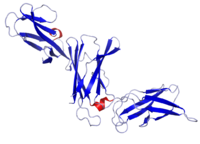Interleukin 23
| IL12B | |
|---|---|

Crystal structure of IL-12B
|
|
| Identifiers | |
| Symbol | IL12B |
| Alt. symbols | CLMF2, NKSF2, p40 |
| Entrez | 3593 |
| HUGO | 5970 |
| OMIM | 161561 |
| PDB | 1F42 |
| RefSeq | NM_002187 |
| UniProt | P29460 |
| Other data | |
| Locus | Chr. 5 q31.1-33.1 |
| interleukin 23, alpha subunit p19 | |
|---|---|
| Identifiers | |
| Symbol | IL23A |
| Entrez | 51561 |
| HUGO | 15488 |
| RefSeq | NM_016584 |
| Other data | |
| Locus | Chr. 12 q13.13 |
Interleukin-23 (IL-23) is a heterodimeric cytokine composed of an IL12B ( IL-12p40 )subunit (that is shared with IL12 ) and the IL23A ( IL-23p19 ) subunit. A functional receptor for IL-23 (the IL-23 receptor) has been identified and is composed of IL-12R β1 and IL-23R.
IL-23 was first described by Robert Kastelein and colleagues at the DNAX research institute using a combination of computational, biochemical and cellular immunology approaches.
Prior to the discovery of IL-23, IL-12 had been proposed to represent a key mediator of inflammation in mouse models of inflammation. However, many studies aimed at assessing the role of IL-12 had blocked the activity of IL-12p40, and were therefore not as specific as thought. Studies which blocked the function of IL-12p35 did not produce the same results as those targeting IL-12p40 as would have been expected if both subunits formed part of IL-12 only.
The discovery of an additional potential binding partner for IL-12p40 led to a reassessment of this role for IL-12. Seminal studies in experimental autoimmune encephalomyelitis, a mouse model of multiple sclerosis, showed that IL-23 was responsible for the inflammation observed, not IL-12 as previously thought. Subsequently, IL-23 was shown to facilitate development of inflammation in numerous other models of immune pathology where IL-12 had previously been implicated including models of arthritis, intestinal inflammation, and psoriasis.
...
Wikipedia
